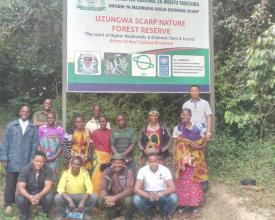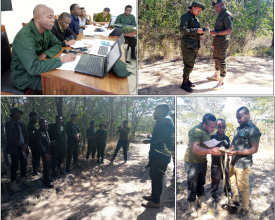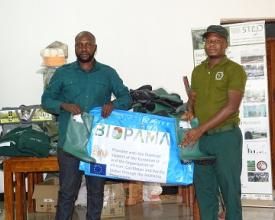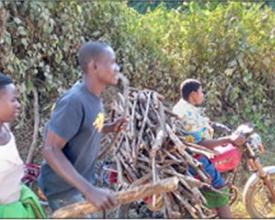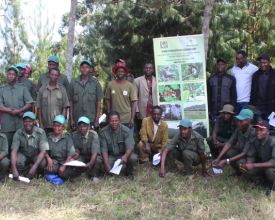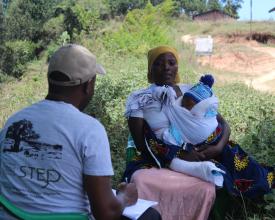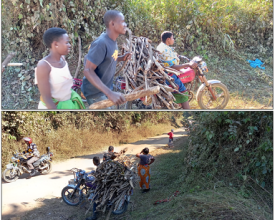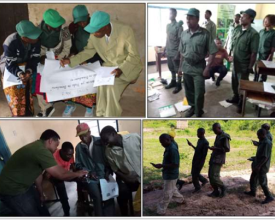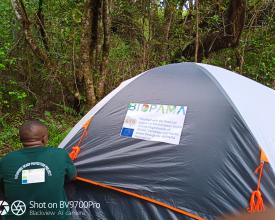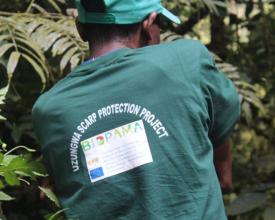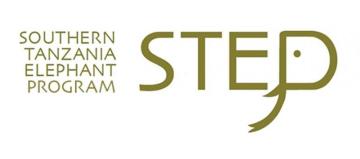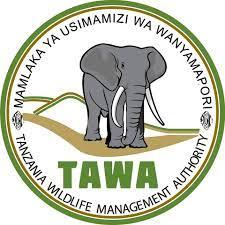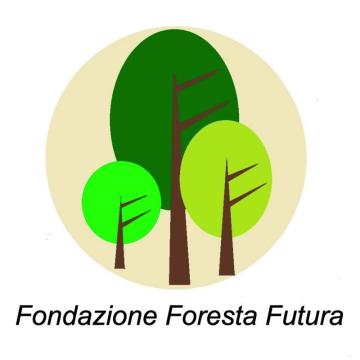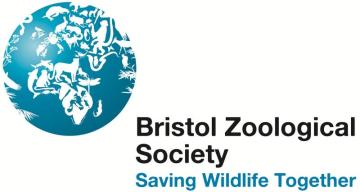Enhancing effective management and protection of the Uzungwa Scarp Nature Forest Reserve, a threatened tropical biodiversity hotspot in Tanzania
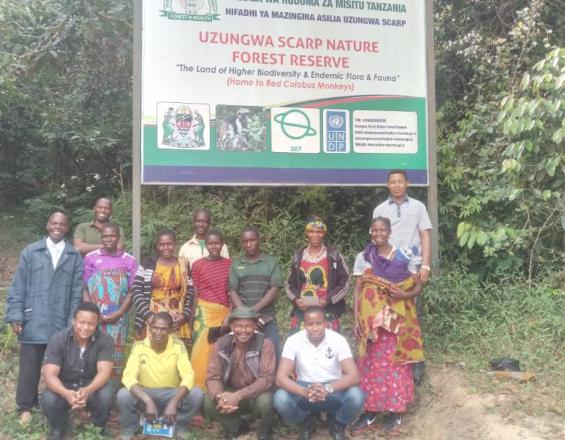
Since 2017, Southern Tanzania Elephant Program (STEP) and the Tanzania Forest Service Agency (TFS) have collaborated to enhance protection programs in the Uzungwa Scarp Nature Forest Reserve (USNFR). The USNFR is a biodiversity hotspot (high density of endemic and IUCN-Endangered species) in Tanzania's Udzungwa Mountains covering 32,000 hectares, surrounded by 19 adjacent villages across three districts of the Iringa and Morogoro Regions. The COVID-19 pandemic limited protection efforts in the USNFR in 2019-2020, resulting in the loss of national and international funding. This led to an abrupt decrease in protection activities during a critical period for the reserve. To restore the situation, this solution was established aimed at preventing the local extinction of threatened species and improving societal benefits. It involved increasing community involvement, building the capacity of patrol teams, and use of data for decision-making. This solution resulted in a significant increase in the protection of the USNFR.
Context
Challenges addressed
The COVID-19 pandemic caused an emergency by reducing funding from agencies and limiting protection efforts in the USNFR since 2019. This led to an abrupt decrease in protection activities during a critical period and a funding gap since September 2020, exacerbating the pressure on the reserve. Forest-adjacent villages suffered from insufficient income, increased dependence on forest resources, and mining activities. Therefore, continuing protection activities was crucial to prevent declines in threatened wildlife and increase the possibility of a self-sustaining solution.
Location
Process
Summary of the process
The first building block enabled local communities to get involved, which is crucial for establishing partnerships and building trust with the USNFR’s management. This block identified gaps that needed to be addressed based on the outcomes of meetings with the VNRCs and through the CBA, forming the foundation for further actions. The second building block and addressed the identified gaps by providing training, equipment, and mentoring through joint patrol operations with local communities. This increased the effectiveness of natural resource management and reduced pressure on the forest. The last building block encouraged the adoption of conservation technologies and the use of data for informed decision-making. This facilitated proper resource allocation and intervention in illegal activities. Overall, the three building blocks increased joint protection activities and contributed to sustainability.
Building Blocks
Increased Community Involvement
The purpose of the community engagement was to increase partnership and community involvement in the management of the USNFR. This led into achieving conservation goals and also increased benefits to local communities through:
- Meetings with Village Natural Resources Committees (VNRCs) which resulted in exploration of the means of collaboration, and a way forward in intervening the issues faced by them.
- Conducting Community Benefits Assessment (CBA) to assess the perceived benefits of the forest reserve by local communities, which revealed that a majority of respondents agree that using the forest reserve brings them benefits.
- The results of CBA led into the solution to facilitated access to non-timber forest products and social services provided by the USNFR through special permits supervised by VNRCs.
Enabling factors
- Existing structures at the village level such as good village leadership and the VNRCs help in building trust and good relationships with local communities to encourage their participation and support
- Actors (village leaders, local communities, local government, and TFS) willingness to support the solution
- Continuous involvement of the adjacent local communities
Lesson learned
- Meetings with local communities (the VNRCs) were essential to build trust, and means of communication and establish partnerships between them and the USNFR’s management
- Conducting CBA provided valuable insights into local perceptions of the Joint Forest Management (JFM) and needs in terms of benefits accrued from the USNFR
- Collaborating with adjacent local communities enhanced project outcomes and increased the means of sustainability
- Access to Non-Timber Forest Products (NTFPs) and social services was an important incentive for local communities to support conservation efforts
Capacity Building to the Patrol Teams
The solution trained 214 Village Game Scouts (VGS) from 19 adjacent villages to USNFR, including 32% women, on Human Rights, the use of Global Positioning System (GPS) handheld devices, and Participatory Management of the Nature Reserve. Additionally, the project provided patrol gear such as uniforms, gumboots, tents, GPS handheld devices, etc., to facilitate effective mobile camping patrol operations. The solution also supported joint foot anti-poaching patrol operations (which mentors local communities), mentoring local communities to conduct their own patrols in respective forest adjacent areas. The patrol teams consisted of TSF staff (22.3%), VGS formed from local communities (44.5%), and anti-poaching unit rangers (33.2%), with 10.4% women of all participants indicating increases in their participation. These efforts increased protection activities, reduced pressure from the forest, and ensured the sustained supply of goods and services that the forests offer. As a result, other villagers were willing to offer intelligent information on poaching incidents.
Enabling factors
Enabling factors that are important to enabling the success of "Capacity Building to the Patrol Teams" are:
- Joint foot anti-poaching patrol operations that mentor local communities.
- A diverse and representative patrol team consisting of TSF staff, local communities (VGS) formed from local communities, and anti-poaching unit rangers.
- Considering gender in the process
- Existing national frameworks and regulations which allow VGS to participate in the protection activities of Nature Reserves
- Willingness of other villagers to participate
Lesson learned
We learned the following key lessons during the implementation of this building block:
- Local communities must be involved and trained in natural resource management to ensure the sustainability of conservation efforts since they have the responsibility of protecting the resources beneath them
- Providing adequate gear and equipment to local communities increased their effectiveness in protecting the environment
- Joint foot anti-poaching patrol operations involving local communities helped mentor them and enabled them to conduct their patrols in their respective forest-adjacent villages, reducing pressure on the forest and improving anti-poaching efficiency
- It is crucial to ensure that patrol teams are diverse and representative, especially with the involvement of women, to improve community engagement and participation
- Awareness-raising campaigns must be coupled with capacity-building efforts to ensure that communities understand the importance of conservation efforts and their role in the process
Use of Data for Decision-making
The building block emphasized the importance of using data for informed decision-making in conservation efforts. To facilitate this, the solution promoted the adoption of conservation technologies such as Survey 123, camera traps, and GIS software. The use of these technologies enabled more efficient and effective data collection and improved the planning of strategic patrols, while also incorporating intelligence data from community members. The adoption of GIS software and the Protected Areas Management System (PAMS) using the Survey 123 Mobile Data Collector provided tools to create hotspot maps, tables, and charts, making it easier to identify priority areas and plan targeted interventions. The use of data resulted in targeted conservation efforts, which improved the overall conservation strategy and highlighted the critical role of data in conservation efforts, and increased joint protection activities.
Enabling factors
Enabling factors of the Use of Data for Decision-making include:
- Readiness of the actors in the adoption of conservation technologies such as Survey 123, camera traps, and GIS software
- The willingness of the adjacent local communities to share the intelligence data that really improve the protection activities
- Improved planning of strategic patrols (use of intelligence information, hotspot maps, tables, and charts to identify priority areas and plan targeted interventions)
- Commitment to using data for informed decision-making
Lesson learned
This building block emphasized the importance of using data for informed decision-making in conservation efforts. Some key lessons learned include establishing feedback mechanisms and community involvement were key to success. While technology significantly improved data collection and analysis, it also posed some challenges regarding equipment maintenance and data management. Adequate resources and technical support were essential to overcome these challenges. Overall, this approach resulted in a more effective conservation strategy, highlighting the critical role of data and community involvement in conservation efforts.
Impacts
The solution increased USNFR's protection by reducing illegal activities. This was done through measures like involving local communities in meetings and joint patrols (40% Village Natural Resource Committee members), Community Benefits Assessments (CBA), and increasing access to Non-Timber Forest Products (NTFPs) in the village forests and buffer areas. The solution also trained 214 local communities (32% women) in Participatory Forest Management and 17 (14% women) in the use of Mobile data Collector and Camera trapping to strengthen the capacity of patrol teams. Teams were equipped with patrol gears, maintained patrol vehicles, and conducted 22 mobile camping joint patrol operations with technical support. Furthermore, STEP facilitated the use of conservation technologies like Survey 123, camera traps, and GIS and GPS to collect, store, analyze data, and use it in decision-making.
Beneficiaries
Engagement from 19 adjacent villages increased reserve protection, secured forest health, and provided NTFP access and water supply. Joint patrol teams from local institutions directly benefited from training, experience, and diverse solution activities.
Sustainable Development Goals
Story
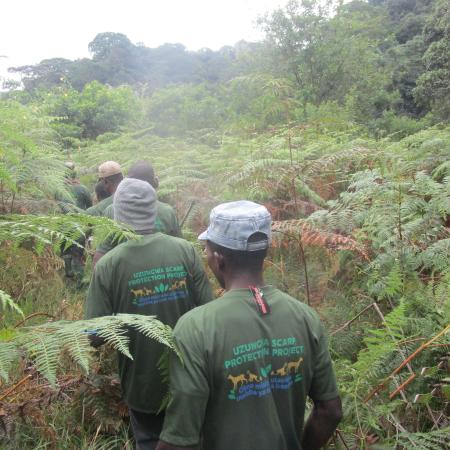
The Uzungwa Scarp Nature Forest Reserve (USNFR) in Tanzania was once under threat from illegal logging, poaching, and encroachment. The reserve housed many plant and animal species. Among them was the endangered Udzungwa red colobus monkey. It was also a crucial water catchment area. It supplied water to the Kilombero Valley and the Kihansi Hydropower Project. The latter generated 15-20% of Tanzania's hydroelectricity. However, the reserve struggled to protect itself, and the local communities were not fully engaged in conservation efforts.
To address this issue, the USNFR and STEP NGO came together and implemented a Joint Forest Management approach. This involved holding community meetings to discuss the importance of the reserve and the threats it faced. Collaborators worked with community members to develop a plan of action and then trained and equipped them to become part of the patrol teams. The adjacent communities were taught how to identify and report illegal activities and work with authorities to take action against those involved. The solution aimed to use data to inform their decision-making and improve the effectiveness of patrols.
The results of this solution were inspiring. The participation of the adjacent local communities significantly increased, leading to a reduction in illegal activities. The patrols became more efficient, and community members took pride in their involvement in protecting the reserve.
One success story stands out. During a patrol, a suspect involved in logging was caught. Instead of punishing him, the patrol team provided him with conservation education and warned him about the consequences of his actions. He was then taken to his village office for further action. After three months, he became an advocate for the protection of the USNFR. He joined the Village Natural Resources Committee and became an integral part of the team, working tirelessly to protect the reserve and its inhabitants.
The improved participation of the adjacent local communities in the protection of the USNFR is a true example of the power of community engagement in conservation efforts. It not only protected the reserve but also provided economic opportunities for the communities, as they were involved in ecotourism activities in the reserve. This solution proves that when communities are involved and empowered, they can become active partners in conservation efforts, leading to a sustainable future for all.

